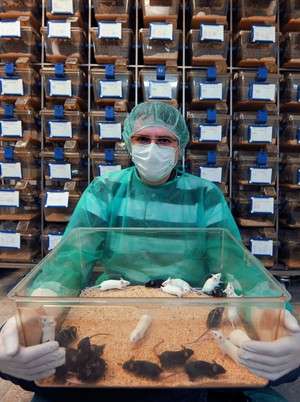Transgenic mice ready to fight obesity—and more

Scientists at the Nencki Institute of Experimental Biology of the Polish Academy of Sciences in Warsaw investigate mice with a very precisely modified genome. Because it is possible to turn off the Dicer gene in adult mice, they can be used to investigate the processes related to such cognitive functions such as learning and memory. Also Nencki scientists have just shown that the new transgenic mouse is suitable to study metabolic dysfunctions resulting in obesity.
Studies on the Dicer gene and its impact on the cognitive and metabolic processes are currently carried out at the Nencki Institute's Laboratory of Animal Models, a core facility in the newly established Neurobiology Center. The Center has been built on Campus Ochota in Warsaw as part of a large European project called the Centre for Preclinical Research and Technology (CePT). This project, financed from the Operational Programme Innovative Economy, brings together 10 research institutions from Warsaw.
"No one needs convincing that knowledge about the function of individual human genes is absolutely fundamental in biology as well as medicine", says Dr Witold Konopka, head of the Laboratory of Animal Models. "But how do we determine a gene's function, if no genetic modifications in humans are allowed? The only method is to create an animal, for example a mouse with genes turned on or off to model the studied illness. This is easy to say, but difficult to do, especially when the involved genes are really important for each cell".
For several years Dr Konopka has been involved in research on the Dicer gene in mice. This gene, the analogue of which can be found also in the human genome, is responsible for creating a protein which reduces RNA molecules to short, 20-nucleotide fragments, important in regulating the activity of other genes. The Dicer gene needs to be active for proper functioning of the cell. It cannot be simply turned off in zygote, because the resulting defect would make the proper development of the zygote impossible.
Preparation of a transgenic mouse, in which the Dicer gene could be blocked in adulthood, takes a year and a half. This process starts with surrounding the Dicer gene on the DNA chain with two sequences known as loxP. This is done on stem cells, which are then injected into the embryo. Since the Dicer gene remains active, the embryo develops normally. At the same time the animal zygote of the opposite sex is injected with a gene coding a protein known as recombinase Cre-ERT2. Molecules of this protein consist of a part containing the Cre enzyme and a fragment reacting to a chemical compound called tamoxifen, which prior to such reaction prohibits recombinase Cre-ERT2 from penetrating into the cell nucleus.
Adult mice of both types are then cross bred for progeny, which will inherit the Dicer gene surrounded with the loxP sequences as well as the gene coding for recombinase from its parents. A mouse of this type has been created thanks to a joint effort of research groups from different world research centres such as the German Cancer Research Center (DKFZ) in Germany or the Imperial College London in the United Kingdom.
In order to turn off the Dicer gene in such adult mouse, it is enough to administer tamoxifen to them for a few days, which accumulates in neurons and allows the recombinase to penetrate into the cell nucleus. The Cre enzyme recognises the loxP sequence and removes the coding fragment with the Dicer gene.
"The first mice, in which the Dicer gene could be switched off at any time, were received by me a few years ago during my postdoctoral fellowship in the German Cancer Research Center in Heidelberg. Currently we breed such mice also the Nencki's Laboratory of Animal Models. But breeding such animals constitutes only a part of the task. If we want to use them for research, they have to be appropriately characterized", explains Dr Konopka.
Traits of mice used for scientific research have to be well known. Without such knowledge researchers cannot determine whether a change observed in the appearance or behaviour of the animal is related to turning off the gene. "Two years ago we have characterized the cognitive processes of these new mice. We have determined that after turning off the Dicer gene the animals showed better memory than the controls", says Dr Konopka. But about five months after deleting the Dicer gene from the brain, the mice scored below the level of the control group on their cognitive abilities, which could be related to dying neurons devoid of the Dicer gene. Currently scientists have just finished analysing changes occurring in metabolic processes of those new mice, which for 3-4 weeks after turning off the Dicer gene eat more and gain weight faster, whereupon their appetite goes back to normal, but higher weight of their bodies' remains.
"Before we have established with the required accuracy, how our mice learn and remember. Now we are certain, that the same mice can be used to investigate obesity and we plan to do that soon. But in our new lab we will not only conduct studies on disease models. We would also like to generate new transgenic animals for other research centres", emphasizes Dr Konopka.
















